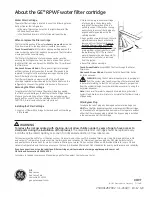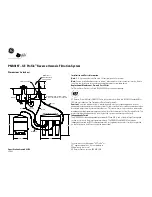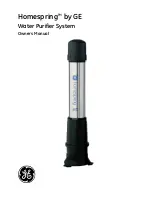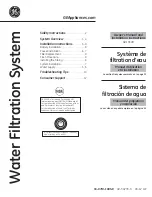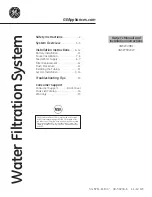
7
Step A –
Use supplied Teflon
®
tape to
wrap the tank nipple with 4 to
8 layers of Teflon tape .
Step B –
Install supplied ball valve
elbow fitting .
(Do not over tighten)
Tank Ball Valve Installation
STEP 10
Step A –
Position tank in desired loca-
tion . Stand it upright or lay it
on its side (using the black
plastic stand) . Measure the
blue tube (marked “TANK”)
from the RO module over to
the tank, and cut it to length
leaving a straight edge on
the end of the tube . Then insert the tube into the Quick-
Connect fitting on the tank ball valve . Make sure the tube
is pushed in all the way to the tube stop (see Page 4 for
Quick-Connect fitting use directions) .
Blue Tube Connection
(From The RO Module To Tank)
STEP 11
Blue Tube Connection
(From The RO Module To Faucet)
Step A –
Determine where the
3
⁄
8
" blue
tubing from the faucet and the
1
⁄
4
" blue tubing (marked “FAU-
CET”) from the RO Module
would join together comfort-
ably . Cut the tubes leaving a
straight cut on both tubes .
Insert the
1
⁄
4
" blue tube (marked
“FAUCET”) from the RO mod-
ule into the
1
⁄
4
" end of the
1
⁄
4
" x
3
⁄
8
" Quick-Connect union
supplied in the parts bag . Make sure the tube is pushed in
all the way to the tube stop .
Step B –
Insert the
3
⁄
8
" blue tube from
the faucet into the remaining
3
⁄
8
" open end of the
1
⁄
4
" x
3
⁄
8
"
Quick-Connect union . Make
sure the tube is pushed in all
the way to the tube stop .
STEP 12
Startup Instructions
Step A–
Turn on the incoming cold water at the angle stop valve .
Turn the knob on the Adapt-A-Valve™ by turning coun-
terclockwise . Check the system for leaks and tighten any
fittings as necessary . (Check frequently over the next 24
hours to ensure no leaks are present) .
Note: If you have connected your RO system to a refrigerator /
ice maker, make sure the ice maker is off (do not allow water to
flow to the ice maker) until flushing is complete and the tank has
been allowed to fill completely. Connection from the RO to the
ice maker system should have an in-line valve installed before
the ice maker so it can easily be closed to prevent water flowing
to the ice maker during start up and periodic maintenance. Your
RO tank must be allowed to fill up fully in order for the ice maker
system to work properly.
Step B –
Open the RO faucet, and leave it open until water begins to
trickle out . (It will come out slowly) .
Step C –
After water trickles out of the faucet, close the RO faucet
allowing the storage tank to fill with water . It may take 4 to
6 hours to fill the tank completely depending on the pro-
duction capability of the membrane, local water tempera-
ture and water pressure .
Note: During the fill period you may hear water trickling due to
the Reverse Osmosis Process.
Step D –
After the Tank has filled, open the RO Faucet to flush the
tank completely to remove carbon particles from Final Fil-
ter . You will know that the tank is empty when the flow rate
from the RO faucet is down to a trickle . Repeat this step
two more times . The fourth tank can be used for drinking .
Note: Flushing of the tank 3 times is only necessary during the
initial startup and after replacing the membrane.
Important: Your reverse osmosis system contains replaceable
treatment components that are critical for effective containment
reduction. Periodic inspection and following proper system
maintenance is critical for continued performance.
STEP 9
Check Air Pressure in the Tank
Note: Check air pressure when tank is empty of water!
Check air pressure in the storage tank when you notice a de-
crease in available water from the RO system. Air can be added
with a bicycle pump using the schrader valve that is located on
the lower side of the tank behind the blue plastic cap.
Step A –
Turn off the incoming water
supply to the RO by turning the
knob on the Adapt-A-Valve™
clockwise until it stops . (Follow
the green tube away from the
RO system to find the Adapt-A-
Valve™ .)
Step B –
Open the RO Faucet and allow water to drain from the tank
until it is completely empty .
Tip: When water from the RO faucet slows to a trickle with the
faucet still in the open position, you may add air to the tank to
purge any left over water. This will ensure that the tank is com-
pletely empty.
Step C –
Once all water in the tank is purged, check air pressure us-
ing an air pressure gauge . It should read between 5 - 7psi .
(Digital air pressure gauge is recommended)
Step D –
Follow Startup Instructions on Page 7 .
Teflon
®
is a registered trademark of E.I. Dupont de Nemours & Company.













